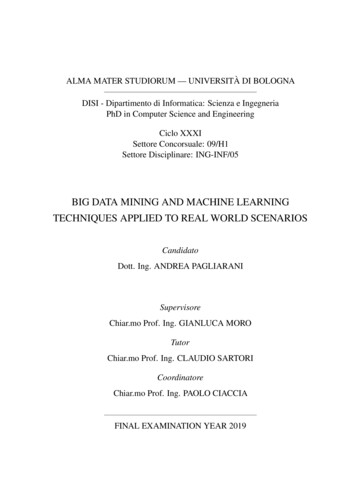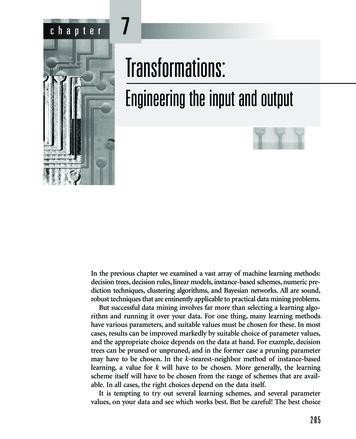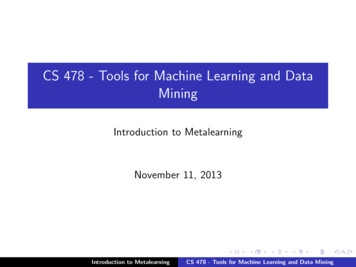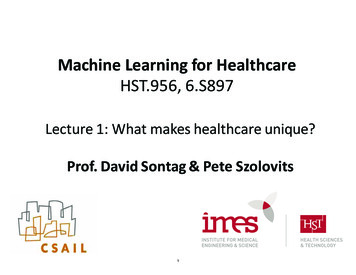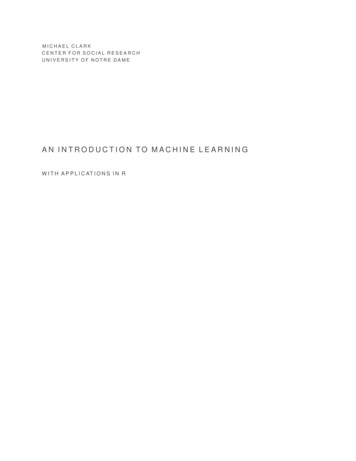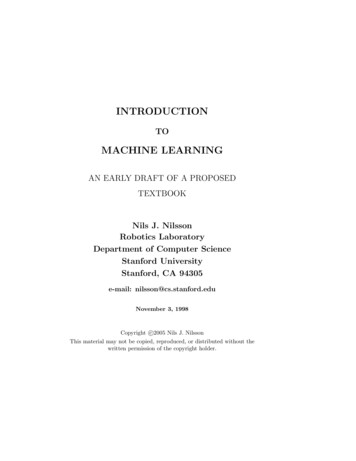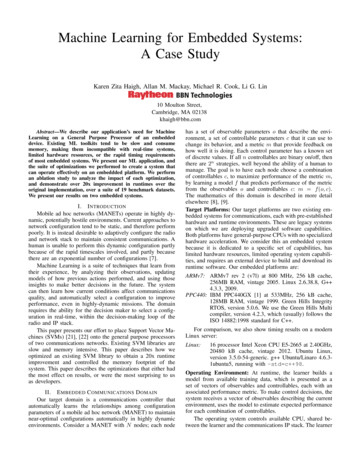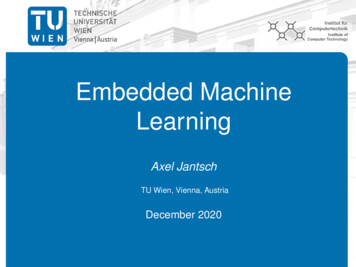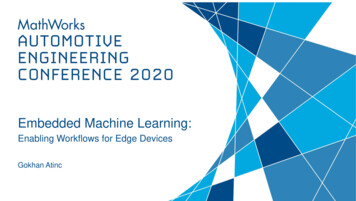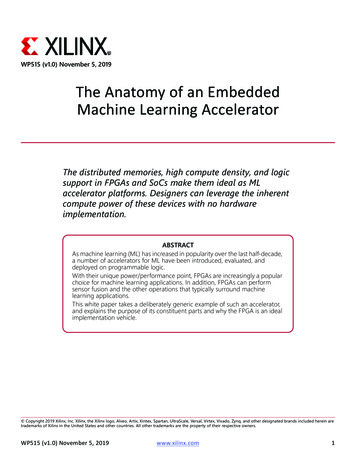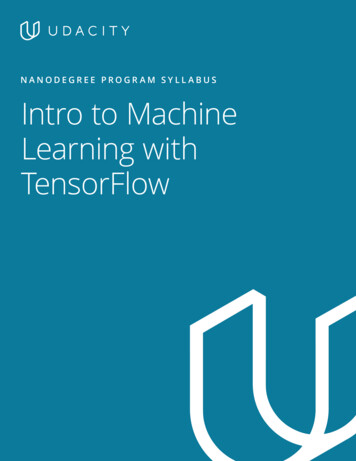
Transcription
NANODEGREE PROGR AM SYLL ABUSIntro to MachineLearning withTensorFlowNeed Help? Speak with an Advisor: www.udacity.com/advisor
OverviewThe ultimate goal of the Intro to Machine Learning with TensorFlow Nanodegree program is to helpstudents learn machine learning techniques such as data transformation and algorithms that can findpatterns in data and apply machine learning algorithms to tasks of their own design.A graduate of this program will be able to: Use Python and SQL to access and analyze data from several different data sources. Build predictive models using a variety of unsupervised and supervised machine learning techniques. Perform feature engineering to improve the performance of machine learning models. Optimize, tune, and improve algorithms according to specific metrics like accuracy and speed. Compare the performances of learned models using suitable metrics.I N CO L L A B O R AT I O N W I T HEstimated Time:3 Months at10 hours / weekPrerequisites:IntermediatePythonFlexible Learning:Self-paced, soyou can learn onthe schedule thatworks best for youNeed Help?udacity.com/advisorDiscuss this programwith an enrollmentadvisor.Need Help? Speak with an Advisor: www.udacity.com/advisorIntro to Machine Learning with TensorFlow 2
To optimize your chances of success in this program, we recommend having experience with:Intermediate Python programming knowledge, including: At least 40 hours of programming experience Familiarity with data structures like dictionaries and lists Experience with libraries like NumPy and pandasBasic knowledge of probability and statistics, including: Experience calculating the probability of an event Familiarity with terms like the mean and variance of a probability distributionThere are a few courses that can help prepare you for this program, depending on the areas you need toaddress. For example: AI Programming with Python Nanodegree Program Intro to Programming Nanodegree ProgramOne of our main goals at Udacity is to help you create a job-ready portfolio of completed projects.Building a project is one of the best ways to test the skills you’ve acquired and to demonstrate yournewfound abilities to future employers or colleagues. Throughout this Nanodegree program, you’ll have theopportunity to prove your skills by building the following projects: Finding Donors for CharityML: Apply supervised learning techniques on data collected for the US census tohelp CharityML (a fictitious charity organization) identify groups of people that are most likely to donate totheir cause. Create Your Own Image Classifier: Define and train a neural network in TensorFlow that learns to classifyimages; going from image data exploration to network training and evaluation. Identify Customer Segments with Arvato: Study a real dataset of customers for a company, and applyseveral unsupervised learning techniques in order to segment customers into similar groups and extractinformation that may be used for marketing or product improvement.Your completed projects will become part of a career portfolio that will demonstrate to potential employers thatyou have skills in data analysis and feature engineering, machine learning algorithms, and training and evaluatingmodels. In the sections below, you’ll find detailed descriptions of each project, along with the course material thatpresents the skills required to complete the project.Need Help? Speak with an Advisor: www.udacity.com/advisorIntro to Machine Learning with TensorFlow 3
Course 1: Supervised LearningIn this course, you will learn about supervised learning, a common class of methods for model construction.Course ProjectFind Donors for CharityMLCharityML is a fictitious charity organization located in the heart ofSilicon Valley that was established to provide financial support forpeople eager to learn machine learning. To expand their potentialdonor base, CharityML has decided to send letters to residents ofCalifornia, but to only those most likely to donate to the charity. Yourgoal will be to evaluate and optimize several different supervisedlearning algorithms to determine which algorithm will provide thehighest donation yield while under some marketing constraints.The key skills demonstrated will include supervised learning,model evaluation and comparison, and tuning models according toconstraints.LEARNING OUTCOMESLESSON ONERegression Learn the difference between Regression and Classification Train a Linear Regression model to predict values Learn to predict states using Logistic RegressionLESSON TWOPerceptronAlgorithms Learn the definition of a perceptron as a building block forneural networks, and the perceptron algorithm forclassification.LESSON THREEDecision Trees Train Decision Trees to predict states Use Entropy to build decision trees, recursivelyNeed Help? Speak with an Advisor: www.udacity.com/advisorIntro to Machine Learning with TensorFlow 4
LESSON FOURNaive Bayes Learn Bayes’ rule, and apply it to predict cases of spammessages using the Naive Bayes algorithm. Train models using Bayesian Learning Complete an exercise that uses Bayesian Learning fornatural language processingLESSON FIVESupport VectorMachines Learn to train a Support Vector Machines to separate data,linearly Use Kernel Methods in order to train SVMs on data that isnot linearly separableEnsemble ofLearners Build data visualizations for quantitative andcategorical data. Create pie, bar, line, scatter, histogram, andboxplot charts. Build professional presentations.LESSON SEVENEvaluation Metrics Learn about different metrics to measure model success. Calculate accuracy, precision, and recall to measure theperformance of your models.LESSON EIGHTTraining and TuningModels Train and test models with Scikit-learn. Choose the best model using evaluation techniques likecross-validation and grid search.LESSON SIXNeed Help? Speak with an Advisor: www.udacity.com/advisorIntro to Machine Learning with TensorFlow 5
Course 2: Neural NetworksIn this course, you will learn the foundations of neural network design and training in TensorFlow.Course ProjectBuild an Image ClassifierImplementing an image classification application using a deepneural network. This application will train a deep learning modelon a dataset of images. It will then use the trained model to classifynew images. You will develop your code in a Jupyter notebook toensure your implementation works well. Key skills demonstratedinclude TensorFlow and neural networks, and model validation andevaluation.LEARNING OUTCOMESLESSON ONEIntroduction toNeuralNetworks Learn the foundations of deep learning and neural networks. Implement gradient descent and backpropagation in Python.LESSON TWOImplementingGradientDescent Implement gradient descent using NumPy matrixmultiplication.LESSON THREETraining NeuralNetworks Learn several techniques to effectively train a neural network. Prevent overfitting of training data and learn best practices forminimizing the error of a network.LESSON FOURDeep Learning withTensorFlow Learn how to use TensorFlow for building deep learningmodels.Need Help? Speak with an Advisor: www.udacity.com/advisorIntro to Machine Learning with TensorFlow 6
Course 3: Unsupervised LearningIn this course, you will learn to implement unsupervised learning methods for different kinds of problemdomains.Course ProjectCreate Customer SegmentsIn this project, you will apply unsupervised learning techniqueson product spending data collected for customers of a wholesaledistributor in Lisbon, Portugal to identify customer segmentshidden in the data. You will first explore and pre-process the data byscaling each product category and then identifying (and removing)unwanted outliers. With the cleaned customer spending data, youwill apply PCA transformations to the data and implement clusteringalgorithms to segment the transformed customer data. Finally, youwill compare the segmentation found with an additional labeling andconsider ways this information could assist the wholesale distributorwith future service changes. Key skills demonstrated include datacleaning, dimensionality reduction with PCA, and unsupervisedclustering.LEARNING OUTCOMESLESSON ONEClustering Learn the basics of clustering data Cluster data with the K-means algorithmLESSON TWOHierarchical andDensity-BasedClustering Cluster data with Single Linkage Clustering. Cluster data with DBSCAN, a clustering method that capturesthe insight that clusters are dense group of pointsLESSON THREEGaussian MixtureModels Cluster data with Gaussian Mixture Models Optimize Gaussian Mixture Models with and ExpectationMaximizationLESSON FOURDimensionalityReduction Reduce the dimensionality of the data using Principal Component Analysis and Independent Component AnalysisvNeed Help? Speak with an Advisor: www.udacity.com/advisorIntro to Machine Learning with TensorFlow 7
Our Classroom ExperienceREAL-WORLD PROJECTSBuild your skills through industry-relevant projects. Getpersonalized feedback from our network of 900 projectreviewers. Our simple interface makes it easy to submityour projects as often as you need and receive unlimitedfeedback on your work.KNOWLEDGEFind answers to your questions with Knowledge, ourproprietary wiki. Search questions asked by other students,connect with technical mentors, and discover in real-timehow to solve the challenges that you encounter.WORKSPACESSee your code in action. Check the output and quality ofyour code by running them on workspaces that are a partof our classroom.QUIZZESCheck your understanding of concepts learned in theprogram by answering simple and auto-graded quizzes.Easily go back to the lessons to brush up on conceptsanytime you get an answer wrong.CUSTOM STUDY PLANSCreate a custom study plan to suit your personal needsand use this plan to keep track of your progress towardyour goal.PROGRESS TRACKERStay on track to complete your Nanodegree program withuseful milestone reminders.Need Help? Speak with an Advisor: www.udacity.com/advisorIntro to Machine Learning with TensorFlow 8
Learn with the BestLuis SerranoI N S T R U C TO RCezanne CamachoC U R R I C U LU M L E A DLuis was formerly a Machine LearningEngineer at Google. He holds a PhD inmathematics from the University ofMichigan, and a Postdoctoral Fellowshipat the University of Quebec at Montreal.Cezanne is a machine learning educatorwith a Masters in Electrical Engineeringfrom Stanford University. As a formerresearcher in genomics and biomedicalimaging, she’s applied machine learning tomedical diagnostic applications.Dan Romuald MbangaMat LeonardI N S T R U C TO RI N S T R U C TO RDan leads Amazon AI’s BusinessDevelopment efforts for Machine LearningServices. Day to day, he works withcustomers—from startups to enterprises—to ensure they are successful at buildingand deploying models on AmazonSageMaker.Mat is a former physicist, researchneuroscientist, and data scientist. He didhis PhD and Postdoctoral Fellowship at theUniversity of California, Berkeley.Need Help? Speak with an Advisor: www.udacity.com/advisorIntro to Machine Learning with TensorFlow 9
Learn with the BestJennifer StaabI N S T R U C TO RSean CarrellI N S T R U C TO RJennifer has a PhD in Computer Scienceand a Masters in Biostatistics; shewas a professor at Florida PolytechnicUniversity. She previously worked at RTIInternational and United Therapeutics asa statistician and computer scientist.Sean Carrell is a former researchmathematician specializing in AlgebraicCombinatorics. He completed his PhD andPostdoctoral Fellowship at the Universityof Waterloo, Canada.Josh BernhardJay AlammarDATA S C I E N T I S TI N S T R U C TO RJosh has been sharing his passion fordata for nearly a decade at all levels ofuniversity, and as Lead Data ScienceInstructor at Galvanize. He’s used datascience for work ranging from cancerresearch to process automation.Jay has a degree in computer science, lovesvisualizing machine learning concepts, andis the Investment Principal at STV, a 500million venture capital fund focused onhigh-technology startups.Need Help? Speak with an Advisor: www.udacity.com/advisorIntro to Machine Learning with TensorFlow 10
Learn with the BestMichael VirgoI N S T R U C TO RMichael is a Content Developer at Udacity,and is currently pursuing a Masters in CS.After beginning his career in business, heutilized Udacity courses and Nanodegreeprograms to build his technical skills,eventually becoming a Self-Driving CarEngineer at Udacity, before switching rolesto work on content.Andrew PasterI N S T R U C TO RAndrew has an engineering degree fromYale and has used his data science skills tobuild a jewelry business from the groundup. He has created courses for Udacity’sSelf-Driving Car Engineer Nanodegreeprogram as well.Juan DelgadoI N S T R U C TO RJuan is a computational physicist with aMasters in Astronomy. He is finishing hisPhD in Biophysics. He previously workedat NASA developing space instrumentsand writing software to analyze largeamounts of scientific data using machinelearning techniques.Need Help? Speak with an Advisor: www.udacity.com/advisorIntro to Machine Learning with TensorFlow 11
All Our Nanodegree Programs Include:EXPERIENCED PROJECT REVIEWERSREVIEWER SERVICES Personalized feedback & line by line code reviews 1600 Reviewers with a 4.85/5 average rating 3 hour average project review turnaround time Unlimited submissions and feedback loops Practical tips and industry best practices Additional suggested resources to improveTECHNICAL MENTOR SUPPORTMENTORSHIP SERVICES Questions answered quickly by our team oftechnical mentors 1000 Mentors with a 4.7/5 average rating Support for all your technical questionsPERSONAL CAREER SERVICESC AREER SUPPORT Resume support Github portfolio review LinkedIn profile optimizationNeed Help? Speak with an Advisor: www.udacity.com/advisorIntro to Machine Learning with TensorFlow 12
Frequently Asked QuestionsPROGR AM OVERVIE WWHY SHOULD I ENROLL?Machine learning is changing countless industries, from health care tofinance to market predictions. Currently, the demand for machine learningengineers far exceeds the supply. In this program, you’ll apply machinelearning techniques to a variety of real-world tasks, such as customersegmentation and image classification. This program is designed to teachyou foundational machine learning skills that data scientists and machinelearning engineers use day-to-day.WHAT JOBS WILL THIS PROGRAM PREPARE ME FOR?This program emphasizes practical coding skills that demonstrate yourability to apply machine learning techniques to a variety of business andresearch tasks. It is designed for people who are new to machine learningand want to build foundational skills in machine learning algorithmsand techniques to either advance within their current field or positionthemselves to learn more advanced skills for a career transition.HOW DO I KNOW IF THIS PROGRAM IS RIGHT FOR ME?This program assumes that you have had several hours of Pythonprogramming experience. Other than that, the only requirement is that youhave a curiosity about machine learning. Do you want to learn more aboutrecommendation systems or voice assistants and how they work? If so, thenthis program is right for you.WHAT IS THE DIFFERENCE BETWEEN INTRO TO MACHINE LEARNINGWITH PYTORCH, AND INTRO TO MACHINE LEARNING WITHTENSORFLOW NANODEGREE PROGRAMS?Both Nanodegree programs begin with the scikit-learn machine learninglibrary, before pivoting to either PyTorch or TensorFlow in the Deep Learningsections.The only difference between the two programs is the deep learningframework utilized for Project 2. As such, there are accompanying lessonsin each respective Nanodegree program that train you to develop machinelearning models in that deep learning framework. You will complete thesame project, Create an Image Classifier, in both Nanodegree programs - inPyTorch in Intro to Machine Learning with PyTorch, and in TensorFlow forIntro to Machine Learning with TensorFlow.ENROLLMENT AND ADMISSIONDO I NEED TO APPLY? WHAT ARE THE ADMISSION CRITERIA?No. This Nanodegree program accepts all applicants regardless ofexperience and specific background.Need Help? Speak with an Advisor: www.udacity.com/advisorIntro to Machine Learning with TensorFlow 13
FAQs ContinuedWHAT ARE THE PREREQUISITES FOR ENROLLMENT?It is recommended that you have the following knowledge, prior to enteringthe program:Intermediate Python programming knowledge, including: At least 40 hours of programming experience Familiarity with data structures like dictionaries and lists Experience with libraries like NumPy and pandas is a plusBasic knowledge of probability and statistics, including: Experience calculating the probability of an event Knowing how to calculate the mean and variance of a probabilitydistribution is a plusIF I DO NOT MEET THE REQUIREMENTS TO ENROLL, WHAT SHOULD I DO?You can still succeed in this program, even if you do not meet the suggestedrequirements. There are a few courses that can help prepare you for theprogram. For example: Intro to Data Science Intro to Programming Nanodegree programDO I HAVE TO TAKE THE INTRO TO MACHINE LEARNING NANODEGREEPROGRAM BEFORE ENROLLING IN THE MACHINE LEARNING ENGINEERNANODEGREE PROGRAM?No. Each program is independent of the other. If you are interested inmachine learning, you should look at the prerequisites for each programto help you decide where you should start your journey to becoming amachine learning engineer.TUITION AND TERM OF PROGR AMHOW IS THIS NANODEGREE PROGRAM STRUCTURED?The Intro to Machine Learning with TensorFlow Nanodegree program iscomprised of content and curriculum to support three (3) projects. Weestimate that students can complete the program in three (3) months,working 10 hours per week.Each project will be reviewed by the Udacity reviewer network. Feedbackwill be provided and if you do not pass the project, you will be asked toresubmit the project until it passes.Need Help? Speak with an Advisor: www.udacity.com/advisorIntro to Machine Learning with TensorFlow 14
FAQs ContinuedHOW LONG IS THIS NANODEGREE PROGRAM?Access to this Nanodegree program runs for the length of time specifiedin the payment card above. If you do not graduate within that time period,you will continue learning with month to month payments. See the Termsof Use and FAQs for other policies regarding the terms of access to ourNanodegree programs.I HAVE GRADUATED FROM THE BUSINESS ANALYTICS NANODEGREEPROGRAM AND I WANT TO KEEP LEARNING. WHERE SHOULD I GO FROMHERE?Many of our graduates continue on to our Machine Learning EngineerNanodegree program, and after that, to the Self-Driving Car Engineer andArtificial Intelligence Nanodegree programs.SOF T WARE AND HARDWAREWHAT SOFTWARE AND VERSIONS WILL I NEED IN THIS PROGRAM?You will need a computer running a 64-bit operating system with at least8GB of RAM, along with administrator account permissions sufficientto install programs including Anaconda with Python 3.x and supportingpackages.Most modern Windows, OS X, and Linux laptops or desktop will work well;we do not recommend a tablet since they typically have less computingpower. We will provide you with instructions to install the required softwarepackages.You will use Python, Scikit-learn, TensorFlow (library in Python used in DeepLearning project), Jupyter Notebook, NumPy, Anaconda, and Pandas in thisNanodegree program.Need Help? Speak with an Advisor: www.udacity.com/advisorIntro to Machine Learning with TensorFlow 15
students learn machine learning techniques such as data transformation and algorithms that can find patterns in data and apply machine learning algorithms to tasks of their own design. A graduate of this program will be able to: Use Python and SQL to acc

